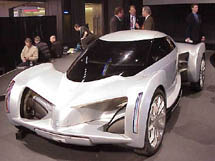|
GM unveils fuel-cell car
|
 |
January 8, 2002: 4:35 p.m. ET
New AUTOnomy sits on a skateboard-like base; Ford says it will incorporate fuel cells into Focus.
By Staff Writer Chris Isidore
|
DETROIT (CNN/Money) - A century ago most cars looked like horse-drawn carriages, as engineers perfecting an economical internal combustion engine had trouble imagining what design opportunities their new technology afforded them.
For years engineers working on developing fuel cells for cars had the same design myopia. As they tried to design cars that would run on plentiful hydrogen fuel and produce only water vapor as exhaust, their efforts looked like modern-day production vehicles, or perhaps slightly more aerodynamic models of the current designs.
But at the North American International Auto Show here this week, General Motors Corp. (GM: down $0.85 to $49.76, Research, Estimates) executives unveiled the AUTOnomy, a radical new concept vehicle in fuel cell development that it says will take the next generation of vehicles far away from their current internal combustion roots.

|
|
|
GM's AUTOnomy concept vehicle shows a way to change the dynamics of auto production and allow fuel cells to compete with the entrenched internal combustion engine, according to company executives. | |
They say their vision might give the technology the advantages it needs to topple the well-entrenched internal combustion engine.
"Certainly it's not a bad thing putting a fuel cell into a traditional vehicle," said Christopher Borroni-Bird, the director of the AUTOnomy program. "But if you want to un-tap the full potential of the fuel cell, you have to not be constricted by internal combustion architecture."
A new theory in vehicle design
AUTOnomy includes a low-slung chassis platform with four wheels attached to it, looking like a skateboard on steroids, that would be the basic building block of all vehicles.
It would contain not only the fuel cells but the vehicle's entire power train, eliminating the need for an engine compartment. That would give designers new flexibility in the use of space in the body of the car. Drivers wouldn't need to look out over an engine, and the space that formerly held an engine could now contain impact-absorbing designs to protect occupants much more efficiently than current cars.
GM also included innovations in the concept vehicle that would allow steering, accelerating and braking information to be transmitted to the engine by wire rather than current steering column or other mechanical levers and equipment, allowing drivers to sit anywhere they want in the vehicles, even the back seat.
| |

|
|
The basic component of GM's plan for a fuel cell vehicle is a so-called skateboard platform that would include both the fuel cells and the vehicle's powertrain, allowing a variety of body types to be economically built and added to the mass-produced six-inch thick chassis. | |
But beyond these radical changes in design, GM executives also say this vision of a new vehicle would make a quantum-leap improvement in the economics of producing a vehicle not seen since Henry Ford's Model T.
The mass production of the "skateboard" chassis could drive down the cost of production, as many different body types could be cheaply added. They even suggested a family might own one chassis and several different interchangeable body types for their different needs.
"Without this new design, I think fuel cells could be economical for stationary uses -- residential power source for example," said Borroni-Bird. "I don't know if it will ever work in a traditional architecture. Designing vehicles around the fuel cell is the way to go."
Fuel cell interest continues to grow
Others automakers are still pursuing the more traditional vehicle for fuel cell use, believing technological breakthroughs will drive down the cost enough to allow fuel cells to be viable.
Ford Motor Co. (F: up $0.06 to $16.56, Research, Estimates) says it will have a limited production fuel cell-powered compact Focus available by 2004, with the market expected to be fleet sales due to limited fueling availability for the vehicles. Other fleet vehicles, especially buses in which the size of the engine compartment is not a major barrier, are already using fuel cells in pilot programs.
U.S. Energy Secretary Spencer Abraham will be here Wednesday to announce a new federally financed research and development program to work on fuel cells, replacing an earlier Partnership for a New Generation of Vehicles program started under the Clinton administration.
The PNGV meant more than $1 billion in research money for the Big Three since it started in 1994. The new program, know as Freedom CAR (Council on Automotive Research) is expected to continue the flow of hundreds of millions of research dollars to the Big Three annually.
Fuel cells are actually well established technology, being used to power spacecraft since the 1960s. But high costs have made them unrealistic for cars to this point.
Still there is greater interest in fuel cell development for vehicles than ever before. A survey of auto industry executives by KPMG LLP put fuel cell development second only behind safety improvements in the innovations they expect during the next five years.
The GM concept of a new type of vehicle to incorporate fuel cells is the most intriguing development out of this week's auto show, according to David Cole, president of the independent Center for Automotive Research, which despite the similar name is not part of the new Department of Energy program.
He believes improvements in fuel cells could lead to the limited production of vehicles for the public within five years, and widespread production of fuel cell vehicles within 10 years.
"What their engineering folks are telling (the automakers) is they have a real shot at it," Cole said.
Cole said that the progress being made on fuel cells has taken the costs from about 1,000 times that of an internal combustion engine to only about 10 times in the last five years.
But the progress being made is actually a barrier to any manufacturer making a major investment in large-scale production of a fuel cell vehicle, because further advances could make the investment quickly obsolete.
"When you're making rapid advances in technology, you dare not commit too early," he said.
Internal combustion engine tough to topple
But despite the time and money being spent on fuel cell development, it's difficult to write off the internal combustion engine anytime soon.
Automakers keep making advances there as well, creating more performance and fuel efficiency. And consumers are reluctant to make a transition over to the new unproven technology when they are generally happy with current vehicles.
"People are not going to put up with anything less than what they have now in terms of performance," said Susan Cischke, vice president of environmental and safety engineering for Ford. "It's tough to beat the internal combustion engine. A lot of refinements have gone into it."
Cischke said she hopes that federal assistance will be available for consumers who choose fuel cell vehicles to help spur the market demand, which in turn can produce the increased production and lower cost needed for profitability. But such subsidies for electric vehicles have produced little more than niche vehicles with very modest pilot programs.
The th!nk electric car produced by the Norwegian unit of Ford has sold only about 400 of the two-seater electric cars, despite $9,000 in incentives in a California program, and a New York program that keeps the lease costs to $199 a month for a three-year lease.
The vehicle has a range of about 60 miles on a single charge, and costs only a dollar or two to recharge. It also meets all U.S. crash standards and weighs only slightly less than the Ford Focus. The incentives basically cut the cost of the $20,000 vehicle in half.
The plant that makes them has only the capacity to make about 3,500 a year. If it had demand for 300,000 of the vehicles a year, that alone could bring down the cost by about half, according to Egil Mollestad, the unit's technical director.
"The main cost of the vehicle is electrical components. With increased production, those costs can drop dramatically," he said. Asked whether technology or buyers' attitudes is the main barrier to increased demand for the vehicle, he responded, "It's definitely attitude." 
|
|
|
|
|
|

|

